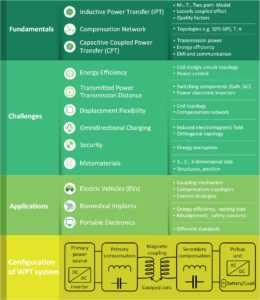Wireless Power Transfer – An Overview
Authors: Zhen Zhang; Hongliang Pang; Apostolos Georgiadis; Carlo Cecati
Extended Abstract:
 Due to their simple use, battery-powered devices are becoming widely required in many fields. Moreover, electric vehicles, and autonomous mobile platforms, are expected to be very popular but their use is severely affected by the high cost, heavy weight, encumbrance and low energy density of the batteries. As a novel pattern of energization, the wireless power transfer (WPT) offers a band new way to the energy acquisition for electric-driven devices, thus alleviating the over-dependence on the battery.
Due to their simple use, battery-powered devices are becoming widely required in many fields. Moreover, electric vehicles, and autonomous mobile platforms, are expected to be very popular but their use is severely affected by the high cost, heavy weight, encumbrance and low energy density of the batteries. As a novel pattern of energization, the wireless power transfer (WPT) offers a band new way to the energy acquisition for electric-driven devices, thus alleviating the over-dependence on the battery.
The paper entitled: Wireless Power Transfer – An Overview, has overviewed the WPT techniques, with emphasis on fundamentals, technical challenges, metamaterials, and typical applications. The manuscript firstly introduced the working mechanism of inductive power transfer (IPT) systems, then, it compared four typical capacitive compensation networks, and elaborated the magnetic resonant coupling effect as well as the capacitive coupled power transfer (CCPT) mechanism. Then, it has given the answers to two technical questions, namely
- why the 2-coils IPT system is commonly used for short-range (shorter than the coil diameter) transmission?
- and why the 4-coils IPT system can extend the transmission distance to the mid-range applications?
The key technical issues of WPT systems have been summarized in terms of the efficiency, power, distance, misalignment, omni-directional charging, and energy security. In addition, it also offered a survey on the studies of metamaterial-based WPT systems. Lastly, some typical applications have also been discussed, including EVs, biomedical implants, and the portable electronics. By overviewing the development and the current state over past years, this paper is expected to offer readers a big image of WPT techniques based on the inductive coupling effect of non-radiative electromagnetic field. This emerging energy transmission mechanism shows significant meanings on the pervasive application of renewable energies in our daily life.
Meanwhile, a discussion about potential future developments are also given in this paper as follows:
- Transmission distance, which will be the most important concern for both researchers and end-users. A real WPT system should harness e the energy over a long distance rather than the wireless-but-contact charging style. However, a long distance means extremely loosely coupling effect for electromagnetic WPT systems. How to break through this technical bottleneck will be the focus of attention in near future.
- Energy security: as similarity with the development of wireless communication, the security of energy will be another key technical challenge for the further development of WPT systems. Regarding to the IPT system, the energy is transmitted via the open electromagnetic field. In other word, it is possible for all involved receptors to access the energy. Then, how to protect the wirelessly-transmitted energy will be an inevitable research topic.
- Bidirectional exchange: as one of typical applications, EVs will be further developed and wide popularized, even completely replacing the conventional internal combustion engine vehicles. In such a case, the energy acquisition will be increasingly important for EVs. As aforementioned, in addition, the V2G technique can make EVs as movable energy buffers, which can effectively balance the power supply and the load. Thus, the bidirectional EV wireless charging will be next hot research topic after the roadway-powering mechanism.
Acknowledgement
This work was supported in part by the National Natural Science Foundation of China (Project No. 51977138), in part by the Humboldt Research Fellowship (Ref 3.5-CHN-1201512-HFST-P), and in part by Project MISE-PON n.F/050220/01-02-03/X32 and n. F/190042/02/X44

